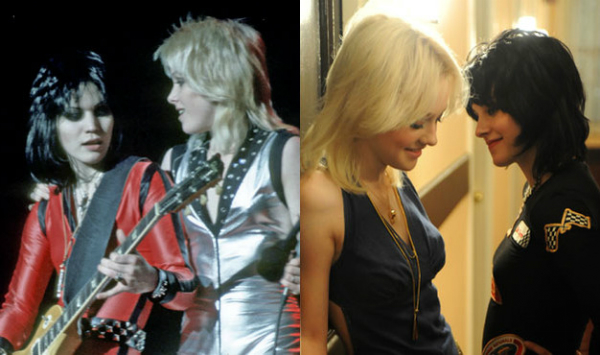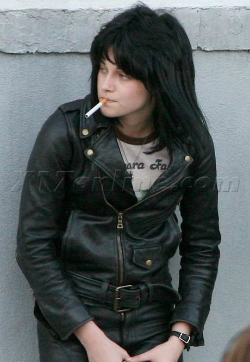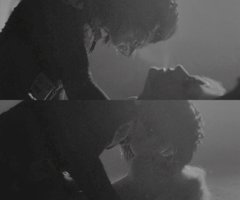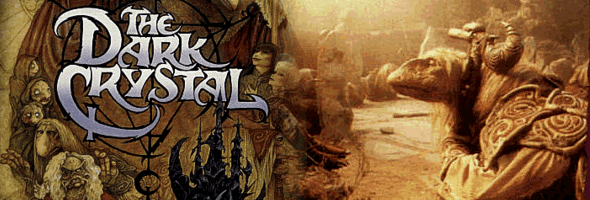
This guest post by Angelina Rodriguez appears as part of our theme week on Movie Soundtracks.
The Runaways, based on Cherie Currie’s autobiography Neon Angel: The Memoir of a Runaway, starring Dakota Fanning and Kristen Stewart, takes us on an adventure through the early lives of rock legends Joan Jett and Cherie Currie.

The actresses go as far as pretending to be left handed when they are both right handed, playing and performing the songs themselves. These women really gave lively and compelling performances. The Runaways encapsulates life for women during the 1970s. It addresses the overt sexism that the all-girl-rock-band experiences, and the loud rock and roll statement they made by harnessing their sexuality and their aggression. These two tough, street smart kids from broken homes helped to pave the path for female rockers of our time. This film does justice to the music the band made in the best way– with an incredible soundtrack.
The film opens with the young Cherie Currie dripping menstrual blood on the sidewalk to the musical stylings of their idol, Suzi Quatro, with “Wild One.” This sets the tone for the film. She is going to be unapologetic, in your face, and confessional about being a girl. Later, the song “Cherry Bomb,” The Runaways’ most famous hit, talks about Cherie’s blossoming sexuality. Women are often sexualized in the media and within their day-to-day lives, but women actually choosing to be sexual and to enjoy their sexuality is a relatively new and radical notion. The song encourages young women to tap into their own power, angst, and sexuality, regardless of what authority figures have to say about it.
“Hello Daddy, hello Mom
I’m your ch ch ch ch ch cherry bomb
Hello world I’m your wild girl
I’m your ch ch ch ch ch cherry bomb”
The introduction scenes for each character parallel in an interesting way. We get to know our Cherie as she lip syncs “Lady Grinning Soul.”

She mimics the movements of this androgynous, iconic male star with precision. She is essentially in drag during this scene. Then we see something similar, as the young Joan Jett lurks around a leather store until she finally buys a jacket. “I want what he’s wearing,” she says and dons what would later become her signature look.

The characters are shown, subverting the gender norms in a very obvious way in the start of the film. They are rebels who simply don’t want to play by the rules of their time. “My brother says guys like girls who are soft and flirty,” Joan’s friend explains to her. “That’s because he’s a pussy.” This statement, although the word “pussy” itself is far less than progressive, explains that Joan feels that men that don’t support female empowerment are simply intimidated. “I Wanna Be Where the Boys Are” is the musical embodiment of this feeling. Both of these girls are desperate for the liberty to express their aggression, their rebellion, and their sexuality like their male peers. There are several songs on the soundtrack that deal with gender, among them “Rebel Rebel” by David Bowie and “It’s A Man’s Man’s World” by MC5.

During the infamous roller rink kissing scene between Joan and Cherie, the mood is set by one of the sexiest songs on the soundtrack; “I Wanna Be Your Dog” performed by The Stooges is heavy with mood and has the kind of bass line you can feel below the belt. Although this scene was likely added for shock value, it’s empowering to see our characters expressing their sexuality in nontraditional, non-monogamos ways. The characters kiss boys and girls, without any need to really speculate on what that means or what their “true identities” are. Seeing the girls behaving outside the confines of labels and societal expectations is liberating. A lot of the other songs seek to sexually empower women, such as “You Drive Me Wild,” “Queens of Noise,” and “Cherry Bomb.”
However, the result of these young stars and their early rock ‘n’ roll careers was a somewhat downward spiral involving drug use and several underplayed abuses. The rock ‘n’ roll engineer, Kim Fowley (played by Michael Shannon), essentially created the band from thin air.

There’s an almost meta dynamic inside the film as we observe one of the most important all-girl rock bands being brought together and greatly influenced by a man. His gaze and his expectations directed the music, the dress, and the attitudes of the band. Of course, some of this came naturally. As Cherie explains in one interview,“We didn’t have to push the envelope, we just had to show up and be ourselves.” The film touches on this when Fowley makes Cherie pose for a scandalous photo shoot even though she doesn’t want to, and gains more media attention than the rest of the band.
As the film ends we are shown the beginning of Joan Jett’s extremely successful solo career with her songs, “I Love Rock n Roll,”“Bad Reputation,” and “Crimson and Clover.” The music throughout the film deals with the lost and rebellious feelings during coming of age for young women. The movie tells the story of these two individuals and how their lives were affected by fame, but underneath that is the coming of age experience for young girls realizing their power and sexuality within a culture that seeks to suppress them. This is close to the hearts of many viewers because we have so much progress to make in the world of arts and entertainment for women. As Joan Jett states in an interview for NYDailyNews, “I don’t think much has changed, to tell you the truth. The media says that equality for women has arrived, but if you look around, you still don’t see girls playing guitars and having success with it.”
Angelina Rodriguez grew up in West Virginia. She will be attending Antioch College in Yellow Springs, Ohio this fall. She spends her time making art and interning with Literacy Volunteers of Harrison County.











